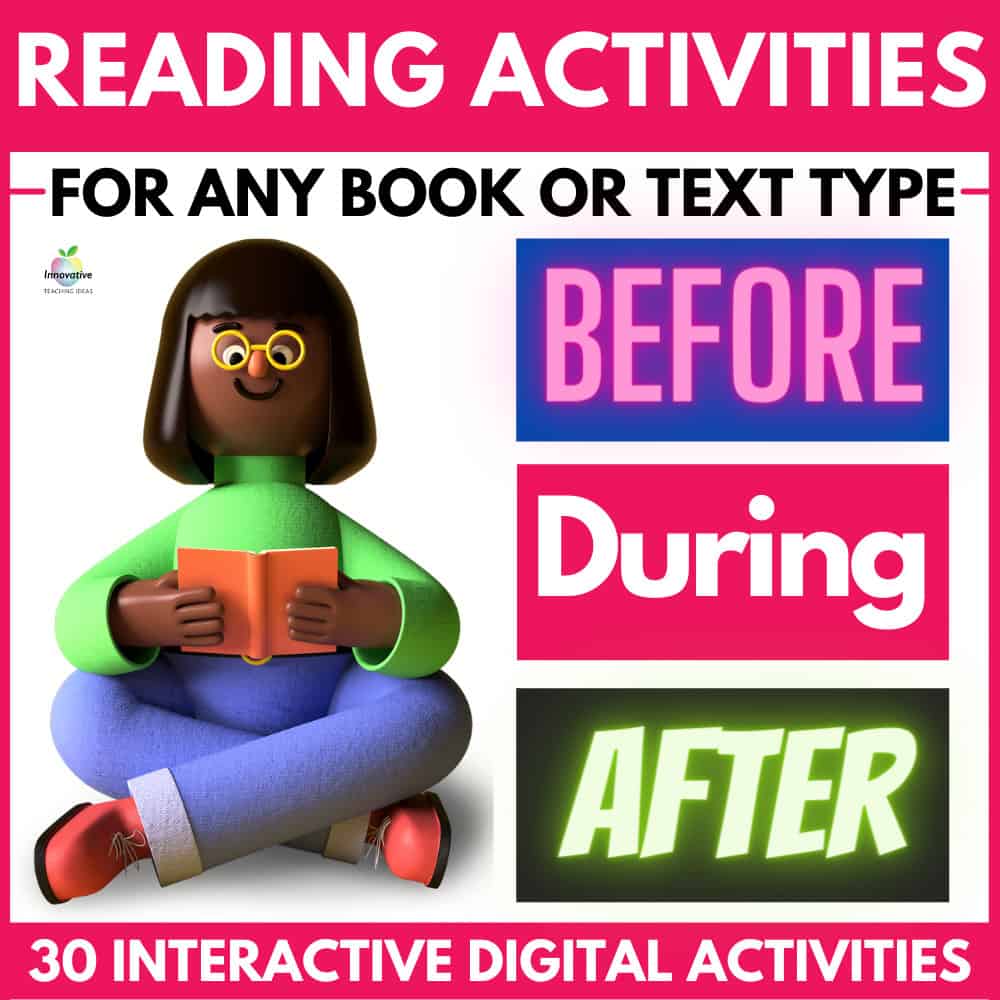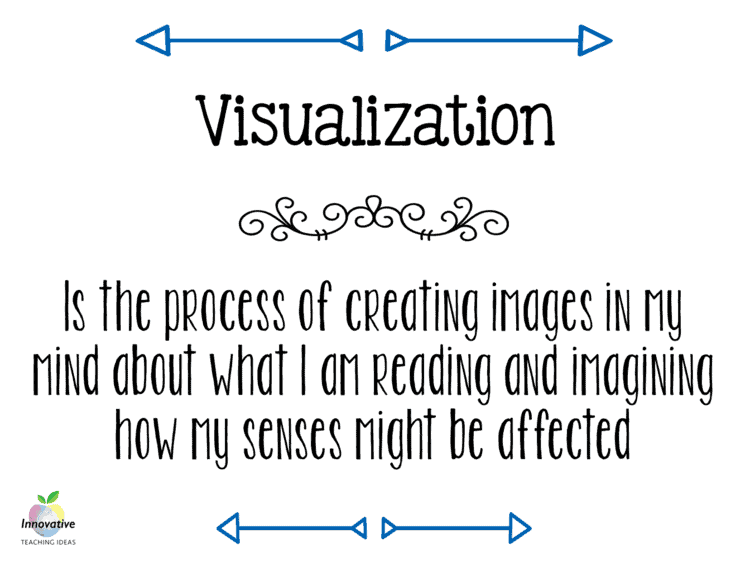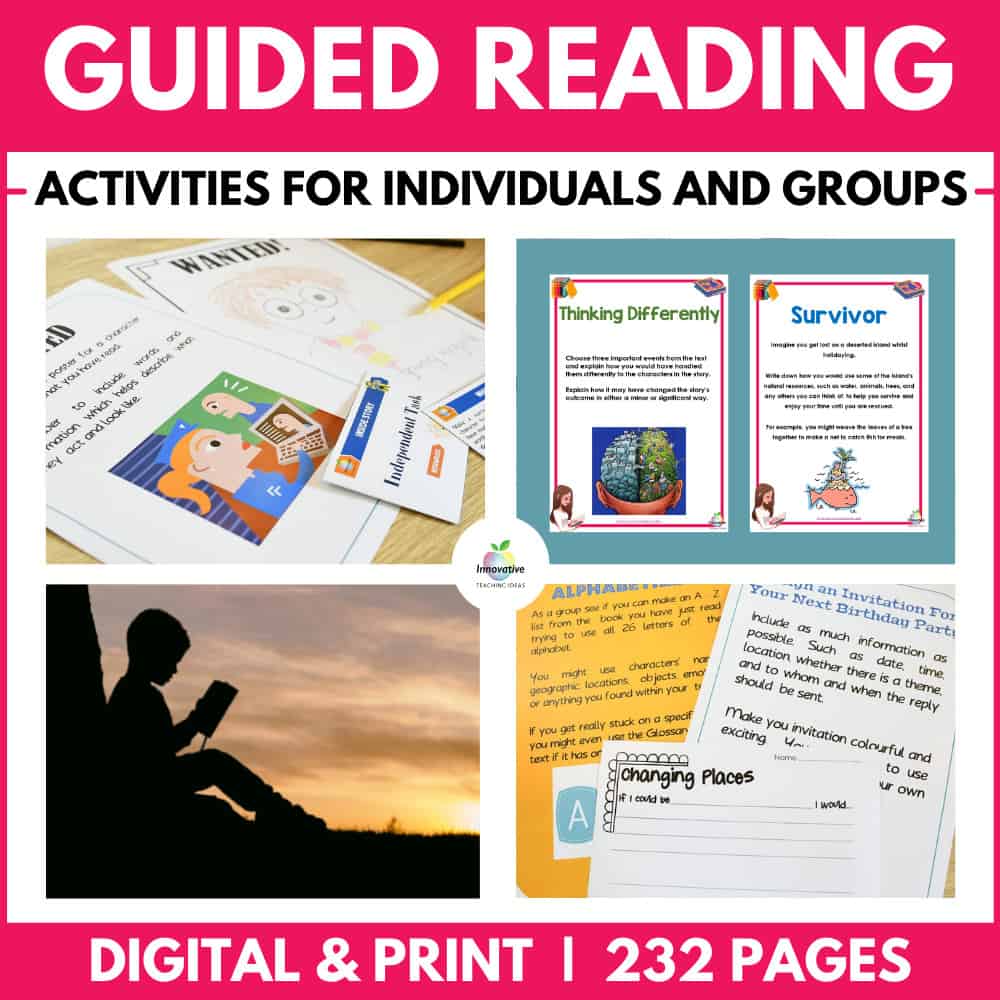
Essential Reading Comprehension Strategies for students and teachers
Learning to read is a complex skill that demands a lot from our students.
Once students have moved on from the relatively easy process of decoding the words on the page and are able to read with a level of fluency and automaticity, increasing demands are made upon their ability to comprehend their reading at evermore complex levels.
One minute they’re being asked to unravel the threads of meaning in a Shakespearean tragedy, the next to wrap their brains around the hard science in a Physics textbook.
There’s no doubt about it; research (not to mention experience) reveals that students require more than a single comprehension strategy to become confident and proficient readers.
In this article, we will examine 7 cognitive strategies that you can use in the classroom to help your students improve their overall reading comprehension.
We’ll also look at how these strategies can be taught in the classroom and provide you with a straightforward activity to get your students started using the strategies right away.
WHAT IS READING COMPREHENSION?
Comprehension is the process of understanding text: spoken, written and/or visual. Comprehension is an active and complex process that encompasses.
- Simultaneously extracting and constructing meaning from text.
- Enabling readers to derive meaning from text when they engage in intentional problem-solving and thinking processes.
- Applying social, cultural and intellectual layers upon text to infer meaning from it.
The teaching of comprehension from the early years of schooling is an important component of any literacy program as it teaches students to think about reading more than simply producing sounds and relaying information.
A COMPLETE DIGITAL READING UNIT FOR STUDENTS

Over 30 engaging activities for students to complete BEFORE, DURING and AFTER reading ANY BOOK
- Compatible with all devices and digital platforms, including GOOGLE CLASSROOM.
- Fun, Engaging, Open-Ended INDEPENDENT tasks.
- 20+ 5-Star Ratings ⭐⭐⭐⭐⭐
THE 7 ESSENTIAL READING COMPREHENSION STRATEGIES
The 7 reading comprehension strategies we’ll look at in this article are:
- Monitoring
- Visualising
- Activating
- Questioning
- Inferring
- Summarising
- Determining Importance
Now, let’s take a look at each of these in turn.
1. MONITORING COMPREHENSION STRATEGY

What is the Monitoring Comprehension Strategy? Put simply, monitoring refers to the process of assessing your understanding of something as you read it. It requires you to pay attention to your own thinking as you read a text. As with all of our reading strategies, this requires students to develop their metacognition – thinking about thinking.
Employing this strategy asks us to notice our own thoughts and filter through them to identify what is new in our reading, what questions arise, what background knowledge do we have and what are inferences that we are making as we read.
Monitoring requires us to do all this and observe how it all weaves together to help us unravel the meaning of a text.
Essentially, the monitoring comprehension strategy requires us to pay close attention and observe not only the text we are reading, but our own thoughts about and observations on the text too.
Done diligently, the monitoring comprehension strategy encourages the reader to assess their understanding of a text on an ongoing basis.
This allows them to make adjustments to their approach to a text as necessary, ensuring they don’t mindlessly scan through a text without understanding what they’ve read. A student who is using this strategy will be an engaged student aware of their current level of understanding and ability to respond accordingly.
Though the monitoring comprehension strategy is only one of the strategies we will explore in this article, it can be thought of as a kind of overarching strategy that can encompass aspects of all the other strategies within it.
How Can I Teach the Monitoring Comprehension Strategy in the Classroom? The earliest method of employing this strategy is most often reading aloud with our students. We encourage interactivity while doing this. We model thinking about the text as we read together, eventually passing over the responsibility for thinking about the text to our students.
To do this, encourage your students to read with partners, to ask questions of each other, and to draw and write about what they’ve read. This encourages the student to think consciously about their reading and their comprehension of it.
Be sure too to expose them to a wide range of genres; both fiction and nonfiction. With enough practice, your students will begin to employ this strategy independently and automatically each time they read.
2. VISUALIZATION COMPREHENSION STRATEGY

What Is the Visualization Comprehension Strategy? Visualization involves the construction of mental images with the purpose of drawing meaning from a text. When engaged in visualization, students will form pictures in their minds of what they have read as they read it.
However, visualization is perhaps a poor name for this strategy with its suggestion of ‘seeing’ alone. Visualization is actually about engaging more than just our sense of sight. Students who are adept at using this strategy will not only make mental images in their minds, but they’ll conjure up in their imaginations the smells, sounds, feel, and tastes of what they read too.
How Can I Teach the Visualization Comprehension Strategy in the Classroom? The best method of teaching this strategy to your students is to use direct modeling. Begin by reading aloud a familiar story. As you read, describe to the students the mental images that you form in your mind.
Once you have given students an insight into your thought processes while reading, then challenge individual students to have a go themselves with short passages, They should read a sentence or two to begin with, then describe the images in their minds as they read them. They should continue in this manner until they complete the passage.
With time, this too will become 2nd nature to the students as another string is added to their bow.
3. ACTIVATING PRIOR KNOWLEDGE COMPREHENSION STRATEGY
What Is the Activating Prior Knowledge Comprehension Strategy? This comprehension strategy encourages students to make connections between what they’re reading and their own experiences. In the process, the student’s reading becomes more personally meaningful.
Prior knowledge is the knowledge that students have already. It’s what the student brings to their reading. The more prior knowledge they have in any given area, the better able they’ll be to comprehend what they read.
As students learn to make connections between the things they read and their own lives, they will begin to develop a scaffold on which they can hang new ideas and concepts.
How Can I Teach the Activating Prior Knowledge Comprehension Strategy in the Classroom? This strategy begins even before the book is opened. First, ask the students to preview the book. Examine the cover and discuss what they see there. Flip through the pages of the book together and read the blurb on the back. Discuss with the students what they think the book might be about based on their observations.
As you read through the book, encourage students to point out when they read something they know already. What else do they know about this topic? Can they share what they know with the class?
As with all the strategies in this article, activating prior knowledge gets us thinking about reading, it is a metacognitive skill as well as a skill that is reliant on the student’s own knowledge and experience.
4. QUESTIONING COMPREHENSION STRATEGY
What Is the Questioning Comprehension Strategy? This comprehension strategy encourages students to think critically about what they read, as well as helps students to develop their own sense of curiosity. Just as we ask our students questions in order to stimulate their thinking, students ask themselves questions about a text to kick start their exploration of the text in pursuit of understanding. Questioning ensures students engage closely with a text, making reading more than just a passive pursuit in the process.
How Can I Teach the Questioning Comprehension Strategy in the Classroom? Instruct students that questioning should take place before, during, and after their reading. It will provide them with purpose and focus for their reading. In this strategy, students will ask questions for several reasons, including to clarify meaning (What does this word mean? Why did that happen?), to understand the events and characters better (Why did she do that? What would happen if…?), and to understand the writer’s purpose (Why did they write that?).
Asking questions is especially important when a student finds themself not understanding what is happening. Asking clarification questions helps the student to seek out the information required to make their comprehension clearer.
5. INFERRING COMPREHENSION STRATEGY

What Is the Inferring Comprehension Strategy? Using this strategy requires the student to become something of a textual detective. It helps students to understand things that are not made explicit in the text. It’s what we mean when we say to students “Read between the lines!”
Rather than simply relying on what the writer has articulated directly in the text, inferring meaning requires the student to look for clues to figure out the meaning behind the text. This demands critical thinking on the part of the student and pushes the student to a higher level of comprehension.
How Can I Teach the Inferring Comprehension Strategy in the Classroom? As with previous strategies, learning to use inferring as a comprehension strategy begins with teacher modeling. Choose a section of suitable text, display the text on a whiteboard or give students copies of it, and read aloud with students. At appropriate points in the text, pause and ask the students what they think is really going on. Teachers should then provide their answer, modeling for the students as they do so which clues in the text led them to their conclusion.
SOME USEFUL PROMPTS FOR ENCOURAGING INFERENCE INCLUDE:
- What’s really going on here?
- How do you think the character feels?
- Why do you think that happened?
- How do you know that?
- What clues led you to that conclusion?
6. Summarizing Comprehension Strategy
What Is the Summarizing Comprehension Strategy? Summarizing means that students retell the story or information in the text they’ve read in their own words. To do this successfully, they need to be able to pull out the main points of the text and express these in their own words. To summarize effectively, the student must express the gist of the text. This requires them to identify the essential ideas and consolidate the most important elements of the text that support these ideas.
How Can I Teach the Summarizing Comprehension Strategy in the Classroom? There are many activities to help students gain valuable practice at summarizing their reading. One fun activity that can be used is the $2 Sum Up. In this activity each word costs 10c and the student only has $2, to sum up the main idea of their reading.
This game is fun, but it also helps push the student to gain a clear grasp of the material they’ve been tasked to summarize. It also offers the student a good opportunity for writing practice as it forces the student to keep their writing lean and tight.
7. Determining Importance Comprehension Strategy
What Is the Determining Importance Comprehension Strategy? There is a sorting process that students must learn if they are to successfully navigate their way through the ocean of words that await them. They’ll need to learn to continuously prioritize the information that they come across when reading. In the determining importance reading comprehension strategy, students look for clues in the text to help them sort the bits of information in the text into a hierarchy of relative value.
How Can I Teach the Determining Importance Comprehension Strategy in the Classroom? Determining importance demands that the student pays attention to all elements of the text. They must analyze everything from headings and bullet points, to the language used in the text right down to the word level.
A simple way to practice this in class is to provide the students with Post-It notes. After reading a provided text, students should make notes of the various bits of information in the text on the Post-It notes. When they have done this they can sort the bits of information according to their overall importance relative to each other.
Turn Over a New Leaf
So, there we have it, 7 reading comprehension strategies to help students get to grips with even the most complex of texts.
Teaching these strategies to your students can ensure they have enough tools in their toolbox to ‘fix’ their comprehension of most texts they’ll be asked to read. If one strategy fails, then they pull out the next one until they have eventually achieved a solid understanding of the text.
While working on improving student reading comprehension, it is important to remind them that the road to becoming a proficient reader demands that they don’t just give up at the first hurdle to understanding. Nor should they plough onwards regardless of the fact the meaning of the text has eluded them either.
With practice and over time, proficient readers develop competency in a range of strategies that they can alternate between to unlock the meaning of even the most opaque of texts.









